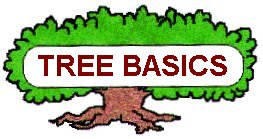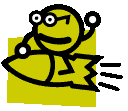
MICHIGAN FORESTS FOREVER
TEACHERS GUIDE
TREE IDENTIFICATION CHARACTERISTICS
OR . . .
WHAT AM I SUPPOSED TO LOOK AT?! |
 |
 Trees are cool.
Learning how to ID trees and learning about their "personalities" is like making
new friends. There’s a lot more to know about trees than just how to tell them
apart! The more time you spend with trees and in the forest, the more you will
understand about some of the neatest places on Earth. But we have to begin somewhere
and ID is a great first step.
Trees are cool.
Learning how to ID trees and learning about their "personalities" is like making
new friends. There’s a lot more to know about trees than just how to tell them
apart! The more time you spend with trees and in the forest, the more you will
understand about some of the neatest places on Earth. But we have to begin somewhere
and ID is a great first step.
 There are certain
parts of a tree that will tell you what species you’re looking at. Usually, we think
only of leaves. But, of course, this doesn’t help us
much in winter if the leaves have fallen (not all do!). Leaves on tall trees that
are only way up in the air don’t help us much either.
There are certain
parts of a tree that will tell you what species you’re looking at. Usually, we think
only of leaves. But, of course, this doesn’t help us
much in winter if the leaves have fallen (not all do!). Leaves on tall trees that
are only way up in the air don’t help us much either.
So, we should learn to look at other parts,
such as twigs, buds, bud scars, bark, flowers, fruits, branching pattern, tree
form, where the tree is growing, and "who" the tree is
growing with. It’s not necessary to learn every characteristic of
every species (although it’s fun). Generally, just one or two features will be
enough … but you have to know which ones are important for which tree!
That’s the hard part. For example, most of us can identify paper birch from
just the bark. But how many of us can tell the difference between maples, elms,
oaks, and ashes without the leaves? (How many of us can do that even with the
leaves!) And, what about all the conifers? Some of the following
considerations will help you look in the correct place in a tree ID book or this on-line
tree ID key.
 |
TWIGS: Slender or chubby? Smooth or hairy?
Any spots, ridges, or special colors?
Boxelder twigs have a purplish color to the most recent growth. |
 |
BUDS:
Pointy or blunt? Shiny or dull?
Hairy or smooth? Big or small? Colors?
Sugar maple have very pointy buds.
Oaks have a cluster of "end" buds. |
 |
BUD SCARS: These are the places where last year’s leaves fell off.
They have shapes, sizes, and "face" patterns unique to each species.
This is helpful with ashes, butternut, walnut, and hickories because the scars are bigger. |
 |
BARK: Rough, smooth, special colors, thickness, patterns,
oddities?
Bark can be difficult to learn because most trees have bark that changes appearance with
age. Only a few trees have really easy bark to recognize, like birches, aspens, or
American elm. |
 |
FLOWERS: We don’t normally think of trees with flowers but all trees
have them. In some cases, the flowers help us with identification. Flowers are
also one of the main parts that scientists have used to put trees in categories. Red
maple is about the first tree to bloom in the spring. |
 |
FRUITS:
All trees have fruits, too. Cones, nuts, acorns, seeds, and helicopters are just
some of the many kinds of fruits that trees produce. A fruit is any kind of organ
that hold seeds, not just edible fruits like apples or oranges. |
 |
BRANCHING
PATTERN: The way in which a tree branches can sometimes be a helpful
thing to know. "Opposite" branching occurs only in maples and ashes (at
least with U.P. trees). Some shrubs also have opposite branching, so identification
of tree saplings may be harder. Most other trees have "alternate"
branching. The angle at which branches come off the trunk, or the density of
branches in the crown, can be good clues in tree ID. Sometimes the crown (all the
branches together) has special characteristics. Paper birch looks purple. |
 |
TREE FORM: The overall shape of a tree is the form.
Some trees have very distinctive forms.
An American elm is shaped like a large flower vase.
Or balsam fir has a very pointy crown. |
 |
GROWING
PLACE or SITE: Some trees, like cedar, black spruce
and tamarack are usually found on wet sites.
Yellow birch and hemlock grow in cooler, moister places
like ravines and the north side of hills. |
 |
TREE
ASSOCIATES: Trees, like people, like to
"hang" around in certain groups. If you can identify one or two trees in
an area, you’ll have some clues to what else might grow there. For example, if
there is a lot of sugar maple, chances are good that you’ll find basswood, beech, and
ironwood. Aspen, paper birch, and jack pine probably won’t be there. |
 |
LEAVES: Leaves include needles and scales of conifers. Leaves are
one of the best ways to ID a tree, when they are available. Simple or
compound? Margins smooth or margins rough? Shape? Size? Color
variation? Texture? Any sinuses or lobes? |
Getting good at identifying trees takes
practice. Once you know your trees, it becomes much easier to learn about shrubs, flowers,
and wildlife that grow together with the trees. Trees dominate forest ecosystems, so
if you have a pretty good idea of what trees are there, you’ll have a pretty good
idea of what’s happening in that environment and what else might be living with those
trees.
 It’s a good thing to know
about trees and forests because we need them for many reasons. So, have fun learning
to identify trees and discovering how they grow! The forest is a great place to
live and work.
It’s a good thing to know
about trees and forests because we need them for many reasons. So, have fun learning
to identify trees and discovering how they grow! The forest is a great place to
live and work.
Tree ID Pages: Michigan Tree Species, ID
Keys, ID Websites, ID Glossary
 |
Activity Suggestions
PLT How Plants Grow |
Return to TOP of
Page
Page Name:
TreeBasics/TreeIDchars.htm



 Trees are cool.
Learning how to ID trees and learning about their "personalities" is like making
new friends. There’s a lot more to know about trees than just how to tell them
apart! The more time you spend with trees and in the forest, the more you will
understand about some of the neatest places on Earth. But we have to begin somewhere
and ID is a great first step.
Trees are cool.
Learning how to ID trees and learning about their "personalities" is like making
new friends. There’s a lot more to know about trees than just how to tell them
apart! The more time you spend with trees and in the forest, the more you will
understand about some of the neatest places on Earth. But we have to begin somewhere
and ID is a great first step.  There are certain
parts of a tree that will tell you what species you’re looking at. Usually, we think
only of leaves. But, of course, this doesn’t help us
much in winter if the leaves have fallen (not all do!). Leaves on tall trees that
are only way up in the air don’t help us much either.
There are certain
parts of a tree that will tell you what species you’re looking at. Usually, we think
only of leaves. But, of course, this doesn’t help us
much in winter if the leaves have fallen (not all do!). Leaves on tall trees that
are only way up in the air don’t help us much either.  It’s a good thing to know
about trees and forests because we need them for many reasons. So, have fun learning
to identify trees and discovering how they grow! The forest is a great place to
live and work.
It’s a good thing to know
about trees and forests because we need them for many reasons. So, have fun learning
to identify trees and discovering how they grow! The forest is a great place to
live and work. 